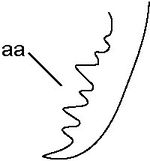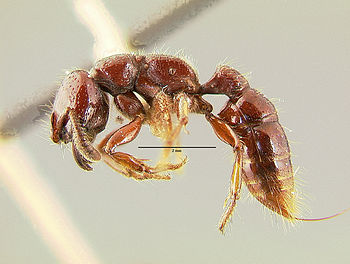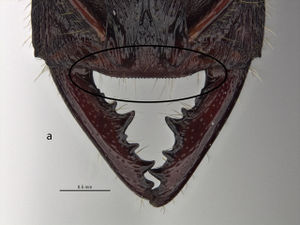AntWiki: The Ants --- Online
1
- Mandibles long, slender and with the teeth (usually 3, sometimes with a few very small denticles as well) grouped together near the tip on a face separate from the rest of the mandible (Fig. a) => Prionopelta
- Mandibles long, slender and with 5 or more teeth that are found along the entire inner surface (Fig. aa) => 2
2
return to couplet #1
- Frontal lobes large and extending well forward of the antennal sockets so that when viewed from the front they cover the underlying clypeus and often form the front margin of the head (Fig. a). Antennae with the last few segments distinctly flattened in cross-section (Fig. b) => Myopopone
- Frontal lobes extending only slightly forward of the antennal sockets and not covering the clypeus when viewed from the front (Fig. aa). Antennae with the last few segments approximately round in cross-section (Fig. bb) => 3
3
return to couplet #2
- Tips of the mandibles rounded and with very short, blunt teeth (Fig. a). Hairs (setae) on head and body broad and rounded (spatulate) (Fig. b) => Mystrium
- Tips of the mandibles with a single distinct, sharp tooth (fig aa). Hairs (setae) on head and body long, thin and tapering to points (Fig. bb) => 4
4
return to couplet #3
- Tibiae of the hind legs with large comb-like (pectinate) spurs (Fig. a). Tooth at the tip of the mandibles no more than twice as long as the next longest tooth (Fig. b) => 5
- Tibiae of the hind legs usually without spurs, but if present they are small, straight and smooth (not pectinate) (Fig. aa). Tooth at the tip of the mandibles at least 4 times longer than the next longest tooth (Fig. bb) => Onychomyrmex
5
return to couplet #4
- Anterior clypeal margin uniformly convex, the clypeal teeth arising directly from this surface (Fig. a) => Amblyopone
- Anterior clypeal margin with a series of low protuberances, each bearing a clypeal tooth (Fig. aa) => Fulakora























